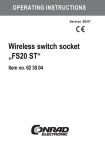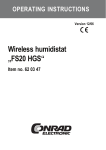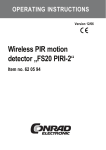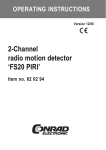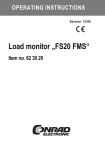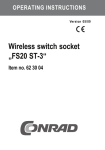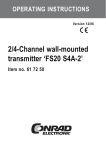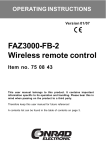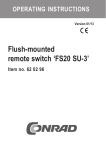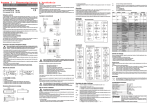Download 2-/4-channel hand-held transmitter „FS20 S4“
Transcript
OPERATING INSTRUCTIONS Version 12/06 2-/4-channel hand-held transmitter „FS20 S4“ Item no. 62 30 25 Introduction Dear customer, Thank you for purchasing this product. This product meets the requirements of both current national and European guidelines. Please read the user manual completely and observe the safety and operation instructions before using the product! This user manual belongs to this product. It contains important information specific to its operation and handling. Please bear this in mind when passing on the product to a third party. Therefore keep this user manual for future reference! All company and product names contained herein are trademarks of their respective owners. All rights reserved. For more inquiries, contact or consult our technical service: Germany: 2 Tel. no.: +49 9604 / 40 88 80 Fax. no.: +49 9604 / 40 88 48 e-mail: [email protected] Mon. to Thur. 8.00am to 4.30pm Fri. 8.00am to 2.00pm Table of contents Page 1. 2. 3. 4. 5. 6. 7. 8. 9. 10. 11. 12. 13. 14. 15. 16. 17. 18. Prescribed use ................................................................................. 4 Scope of delivery ............................................................................. 4 Explanation of icons ......................................................................... 4 Safety instructions ........................................................................... 5 Information on batteries/rechargeable batteries ............................ 6 Inserting the battery, replacing the battery .................................... 7 Control panel .................................................................................... 8 Operation .......................................................................................... 9 a) Basic functions (2-channel operation) ..................................... 9 b) Using several transmitters ...................................................... 10 c) Timer functions (2-channel operation) ................................... 10 d) Saving settings ........................................................................ 11 e) Restoring the factory settings ................................................. 12 Double number of channels (4-channel operation) ..................... 13 a) Switching between 2-channel and 4-channel operation ....... 13 b) Operation in the 4-channel mode ........................................... 14 c) Timer functions (4-channel operation) ................................... 15 FS20 address system basics ........................................................ 16 Programming the hand-held transmitter ....................................... 18 a) Setting the house code ............................................................ 18 b) Setting the addresses (2-channel operation) ........................ 19 c) Setting the addresses (4-channel operation) ........................ 21 Example of an address assignment ............................................. 22 Handling ......................................................................................... 24 Maintenance and cleaning ............................................................ 25 Disposal .......................................................................................... 26 Information on the range ............................................................... 27 Declaration of conformity (DOC) .................................................. 28 Technical specifications ................................................................ 28 3 1. Prescribed use The sole purpose of the ‘FS20S4’ 2-/4-channel hand-held transmitter is to remotely control the various components of the FS20 wireless control system. The components are remotely controllable on 2 channels (two buttons per channel) or 4 channels (one button per channel). Any use other than the one described above may damage the product and cause other dangers. Please read these operating instructions thoroughly and carefully, as they contain important information on operating and handling the product. 2. Scope of delivery • Hand-held transmitter • User manual 3. Explanation of icons The icon with an exclamation mark in a triangle points to important instructions in this user manual that must be observed. 4 The ‘hand’ symbol indicates special tips and information on operation. 4. Safety instructions The product’s guarantee becomes invalid if the product is damaged as a result of failure to observe these operating instructions. We do not assume any liability for any resulting damages! Nor do we assume liability for damage to property or personal injury caused by improper use or failure to observe the safety instructions. In such cases the product’s guarantee becomes invalid! • For safety and licensing (CE) reasons any unauthorised alterations to and/or modification of the product are not permitted. • Do not use this product in hospitals or medical institutions. Although the product emits only relatively weak radio signals, these may cause lifesupport systems to malfunction. This may also be the case in other areas. • Make sure that the product does not get damp or wet. Protect the product against heat, cold, and direct sunlight while in storage or operation. • This product is not a toy. It should be kept out of the reach of children. The product contains small parts, which may be swallowed (battery). • Do not leave packaging material lying around. This may become a dangerous plaything in the hands of children. • Handle the product with care; knocks, blows or even a fall from a low height can damage it. 5 5. Information on batteries/rechargeable batteries • Keep batteries/rechargeable batteries out of the reach of children. • Make sure that the polarity is correct when inserting the button cell (pay attention to positive and negative pole). • Do not leave batteries/rechargeable batteries lying around as they could be swallowed by children or pets. In such case seek immediate medical care. • Leaking or damaged batteries/rechargeable batteries may cause acid burns, if they come into contact with skin. Therefore, please make sure you use suitable protective gloves. • Make sure that batteries/rechargeable batteries are not short-circuited, taken apart or thrown into fire. They might explode! • Conventional batteries must not be recharged. They might explode! • If the device is not used for a longer period of time (for example, when stored), remove the battery to prevent it from leaking and causing damage. 6 6. Inserting the battery, replacing the battery • Open the battery compartment on the rear by turning the battery compartment cover clockwise slightly using a coin (the arrows are in the ‘open’ position). • Insert a ‘CR2016’ lithium button battery, observing the correct polarity. The plus (‘+’) pole has to point outwards towards you. • Replace the battery compartment cover and close it by turning it anticlockwise (position ‘closed’). • If the LED on the front side of the hand-held transmitter does not light up when you press the buttons or you find that the range of the handheld transmitter decreases, then you need to replace the old battery with a new one. Please also see section 8. d). 7 7. Control panel A 1 2 3 4 A Control indicator/LED 1 2 3 4 Channel 1, ‘off’ button, or ‘dim down’ Channel 1, ‘on’ button, or ‘dim up’ Channel 2, ‘off’ button, or ‘dim down’ Channel 2, ‘on’ button, or ‘dim up’ 8 The operation above describes the 2-channel operation of the hand-held transmitter. The buttons or functions are allocated differently for 4-channel operation. This is described later on in the user manual. 8. Operation Please note: In the delivery state the components of the FS20 wireless control system do not respond to remote control commands. They must first be addressed according to the instructions provided in the respective device’s user manual. The setting of the basic functions is then possible. a) Basic functions (2-channel operation) Buttons are pressed quickly (to switch) or longer than 0.4 seconds (to dim). Right button ( 2 or 4): Quick press: ‘On’ Long press (>0.4 sec): ‘Dim up’ Left button ( 1 or 3): Quick press: ‘Off’ Long press (>0.4 sec): ‘Dim down’ The control indicator/LED (A) briefly lights up to signal that a command has been transmitted. Now you can program and operate the basic functions of the FS20 wireless control system components. Also read the following subsections, if you require an extended system with several components or you wish to use the additional functions. 9 b) Using several transmitters In the delivery state each transmitter in the FS20 wireless control system has its own, randomly set house code. If you want to jointly control one or several receivers via different transmitters, you first need to coordinate the transmitters’ house codes. The same house code must be set for each transmitter, as described in section 11. This must be set before programming the receivers for the first time, as the associated house code is also sent to the receiver during this procedure. The transmitters’ channels are already set to the same addresses and only need to be changed, if required (see sections 5 and 6). c) Timer functions (2-channel operation) In order to program a receiver’s timer function you must simultaneously press the button combination that has been assigned to the receiver for between 1 and 5 seconds (1 sec to 5 sec) on the hand-held transmitter. 10 This button combination is used to start as well as to stop the programming of the timer. For information on how to program the timer, see the instructions in the receiver’s user manual. d) Saving settings In the delivery state the ‘FS20S4’ has the following default settings: House code: random Address for channel 1: 11 11 (address group/subaddress) Address for channel 2: 11 12 (address group/subaddress) Address for channel 3: 11 13 (address group/subaddress) Address for channel 4: 11 14 (address group/subaddress) The addresses for channels 3 and 4 are, of course, only active when the ‘FS20S4’ is switched to 4-channel operation. See section 9. You may make changes to the settings (as described in the respective sections of this user manual), for example, setting the house code. These settings are stored in a non-volatile memory and are thus retained even when the battery is replaced. If programming is not completed properly (if only some of the numbers are entered when the house code is entered, for example), then the programming mode is automatically exited after one minute (control indicator/LED stops blinking) and the entered numbers are ignored. If the battery is weak (for example, the range of the ‘FS20S4’ is low), then the programming may no longer be saved properly. You can tell that this is the case, if the control indicator/LED remains lit for 3 seconds after the programming has been carried out correctly. For example, the control indicator/LED remains lit for 3 seconds after the house code has been entered (normally it goes out!). This also applies to other functions, for example, when switching from 2channel operation to 4-channel operation. 11 If this happens, then the programming that you have carried out will not be saved. Replace the battery and then repeat the programming. We recommend that you replace the battery, if the LED lights up for 3 seconds, as described above. e) Restoring the factory settings To reset the ‘FS20S4’ to the factory settings, proceed as follows: 2 4 • Press the and buttons simultaneously for approx. 5 seconds until the control indicator/LED briefly lights up. • With the next press of any button a new random house code is automatically generated and saved along with the other factory settings and the ‘FS20S4’ is reset to the factory settings. See section 8. d). 12 9. Double number of channels (4-channel operation) In addition to the standard 2-channel hand-held transmitter setting (for example, two channels with an on/off button) the ‘FS20S4’ can also be operated as a 4-channel transmitter. Only one button is available to each channel, and there are no more button combinations. a) Switching between 2- and 4-channel operation • Switching to a double number of channels (4-channel hand-held transmitter): 2 3 Press the and buttons simultaneously for at least 5 seconds (the upper right and lower left buttons on the hand-held transmitter). The control indicator/LED on the hand-held transmitter blinks briefly to confirm the setting. The hand-held transmitter is now in 4-channel operation and each button now has its own channel. • Switching to a normal number of channels (2-channel hand-held transmitter): 1 4 and buttons simultaneously for at least 5 seconds Press the (the upper left and lower right buttons on the hand-held transmitter). The control indicator/LED on the hand-held transmitter blinks briefly to confirm the setting. The hand-held transmitter is once again in the normal 2-channel operating mode. Please note: Different operating and programming instructions apply when a double number of channels has been set! 13 b) Operation in the 4-channel mode In 4-channel operation each of the 4 buttons on the hand-held transmitter has its own channel (compare with the figure in section 7): 1 2 Channel 1 Channel 2 3 4 Channel 3 Channel 4 For this reason operation is different than in the 2-channel mode. However, switching and dimming functions are still available in 4-channel operation. Proceed as follows: • Switching Pressing a button briefly (for fewer than 0.4 seconds) sends a switching command. The addressed receiver changes its switch state from OFF to ON or ON to OFF, depending on which switch state was previously active. • Dimming If a button is pressed for longer then 0.4 seconds, a corresponding dim up or dim down command is sent until the button is released (lamp is dimmed up to the maximum and then dimmed down to the minimum, and so on). Here too, the dimming proceeds in the direction opposite to that of the previously sent command, that is, if dim up was the last command, then the next time the button is pressed a dim down command is sent. 14 The control indicator/LED (A) briefly lights up to signal that a command has been transmitted. c) Timer functions (4-channel operation) In order to program a receiver’s timer function, proceed as follows: • Press the button that is assigned to the receiver and keep it pressed (do not release the button yet!). • Press the button to the left, or right, for 1 to 5 seconds (1 sec to 5 sec) and then release it. Only afterwards should you release the button that you pressed first. This procedure is used to start as well as to stop the programming of the timer. For information on how to program the timer, see the instructions in the receiver’s user manual. 15 10. FS20 address system basics The FS20 wireless control system (to which the ‘FS20S4’ 2-/4-channel hand-held transmitter belongs) works with its own ‘house code’. This means that your neighbour can also use the same wireless control system and the two systems will not interfere with each other (provided that the house code has been programmed differently). 256 different addresses can be set within a house code. These addresses are divided into 4 address types (available number is in brackets): • Single addresses (225) • Function group addresses (15) • Local master addresses (15) • Global master address (1) One address from each address type can be assigned to each receiver. This means that each receiver can respond to up to 4 different addresses, but only ever to one address per address type. If you need a receiver to respond to more than one transmitter, you can program the transmitters to the same address or, if different transmitter address types have been set, you can program the receiver consecutively to these different addresses. The individual address types have the following function: • Single addresses Each receiver should be set to a single address so that it can be controlled separately. 16 • Function group addresses Several receivers are defined as a functional unit by being assigned to a function group address. If, for example, all the lamps in a house are assigned to a function group, then all the lamps in the entire house can be switched on or off by pressing one button. • Local master addresses Several receivers are spatially defined as one unit and controlled via the local master address. If, for example, all the receivers in a room are each allocated to a local master address, then all you need to do is press one button when leaving the room to switch off all the consumer loads in the room. • Global master address Several receivers are assigned to the global master address and are jointly controlled via this address. All the consumer loads can easily be switched off simply by pressing one single button when leaving a house, for example. This address system opens up a variety of possibilities. You can even implement access authorisations; by assigning three garage doors to different single addresses and a joint function group (‘Garage doors’), for example. Several people can then each be given a hand-held transmitter with a relevant single address for one garage door, while all the garage doors can be opened via a hand-held transmitter with a programmed function group address or all the doors can be automatically closed in the evening via an FS20 timer. The various address types and addresses are only set on the transmitter and these settings are transmitted to the receivers via the address assignment. 17 11. Programming the hand-held transmitter The house code, an address group and a subaddress are used for coding the transmitters and their individual buttons. You can also use special address group assignments to program the hand-held transmitter as a local or global master. To set the addresses and codes, the 4 buttons on the hand-held transmitter are used, which have the numbers 1, 2, 3 and 4. 1 2 Number ‘1’ Number ‘2’ 3 4 Number ‘3’ Number ‘4’ a) Setting the house code Once the battery has been inserted the hand-held transmitter selects a random house code. To choose your own house code, proceed as follows: 1 • Keep both left buttons on the hand-held transmitter (buttons and ) pressed for 5 seconds until the control indicator/LED (A) begins to blink every second. • Now use the 4 buttons to enter your system’s 8-digit house code. This must be identical for all the remote control transmitters in the same system (as a precaution, make a note of this code and keep it safe!). • The programming mode ends automatically once you have entered the eighth digit. The control indicator/LED (A) goes out. 3 Example: 23141342 18 b) Setting the addresses (2-channel operation) A channel’s address comprises a 2-digit address group and a 2-digit subaddress. Example: 1131, address group 11, subaddress 31 The address group ‘11’ is factory set for both channels. Subaddress ‘11’ is pre-programmed for channel 1 and subaddress ‘12’ is pre-programmed for channel 2. Channel: 1 2 Address: 11 11 11 12 If several transmitters are to be operated at the same time and control different receivers, then different addresses need to be set on the transmitters. 1. Setting a single address (address group/subaddress) • Press both buttons of the respective button combination simultaneously for at least 5 seconds (for example, the buttons and for channel 1). • Enter a 2-digit address group and a 2-digit subaddress using the , and buttons. 1 2 The control indictor/LED (A) now blinks every second. 23 4 1, Example: 1431 (address group 14, subaddress 31) • The programming mode ends automatically once you have entered the fourth digit. The control indicator/LED (A) goes out. Please note: The address group 44 and the subaddress 44 both have a particular meaning (see the following item)! 19 2. Assigning function groups and master addresses • Function groups (44xx) If you enter 44 as the address group, then the subaddress (provided this is not also set to 44; see the following section) is defined as a function group. 15 different function groups between 4411 and 4443 can then be defined. • The following are possible: 4411, 4412, 4413, 4414, 4421, 4422, 4423, 4424, 4431, 4432, 4433, 4434, 4441, 4442, 4443 Local master (xx44) If you only set the subaddress to 44, then this channel functions as a local master within the set address group. All receivers that are programmed with this local master address are controlled simultaneously. • The following are possible: 1144, 1244, 1344, 1444, 2144, 2244, 2344, 2444, 3144, 3244, 3344, 3444, 4144, 4244, 4344 Global master (4444) If you set the address group and subaddress of a channel to 44, then this channel functions as a global master. All receivers that are programmed with this global master address are controlled simultaneously. 20 The only global master is 4444. b) Setting the addresses (4-channel operation) If the ‘FS20S4’ is operated in the 4-channel mode, proceed as follows in order to change the address group and subaddress of the respective button: • Press and hold the button to be programmed. • Now also press the button next to it. Keep both buttons pressed simultaneously for at least 5 seconds! • Wait until the control indicator/LED (A) blinks every second indicating that the programming mode is activated. • Enter a 2-digit address group and a 2-digit subaddress using the , and buttons. • The programming mode ends automatically once you have entered the fourth digit. The control indicator/LED (A) goes out. 23 4 1, Example: 1112 (11 = address group, 12 = subaddress) 21 12. Example of an address assignment When you require a large, extended system, it is advisable to select addresses systematically so that you have an overview of the addresses that have already been assigned and so that you can jointly control the programmed receivers simply and logically in groups. House code, e.g. 1234 1234 Global master address 4444 Function group 44xx e.g. 4411 ceiling lamps A Local master address e.g. 1144 D 112 2 114 4 444 4 113 1 114 4 444 4 B 121 1 111 1 114 4 441 1 444 4 121 2 441 1 444 4 141 2 444 4 141 1 441 1 444 4 C 131 1 441 1 444 4 A different address group has been assigned to each room: • • • • 22 Room A: 11 Room B: 12 (the awning is also assigned to room B) Room C: 13 Room D: 14 15 address groups are possible: 11, 12, 13, 14, 21, 22, 23, 24, 31, 32, 33, 34, 41, 42, 43 In order to be able to separately control each receiver, you need to program each receiver to a single address. In addition to the address group that is already selected (room A: 11, room B: 12, room C: 13, room D: 14), a subaddress is also needed. The following 15 subaddresses are possible for each address group: 11, 12, 13, 14, 21, 22, 23, 24, 31, 32, 33, 34, 41, 42, 43 In the example the awning is programmed to the single address 1211, which comprises the address group 12 and its subaddress 11. All the receivers in room A have also been programmed to a local master address (1144 in the example). For the local master address 44 is always set as the subaddress, while one of the 15 local master addresses (11, 12, 13, 14, 21, 22, 23, 24, 31, 32, 33, 34, 41, 42, 43) can be selected via the address group. Example: 1144, address group 11, subaddress 44 All the lamps in the house can be controlled via the global master address 4444. The awning was deliberately not programmed to this address and can therefore only be addressed via its single address (1211). It must be operated separately in this example. The ceiling lamps in all the rooms are also combined in a function group (4411 in the example, address group 44, subaddress 11) and can therefore be jointly controlled. To select one of the 15 function groups, you need to set 44 as the address group and a value between 11 and 43 (11, 12, 13, 14, 21, 22, 23, 24, 31, 32, 33, 34, 41, 42, 43) as the subaddress. 23 13. Handling The product must not be opened or taken apart (apart from when replacing the battery, as described in this user manual). There are no serviceable parts inside the product. The licence (CE) and the guarantee/warrantee become invalid, if you open the device or take it apart. Avoid the following unfavourable ambient conditions when operating or transporting the device. • Moisture or excessive air humidity • Extreme cold or heat • Direct sunlight • Dust or flammable gases, vapours or solvents • Strong vibrations • Strong magnetic fields such as those found near machines or loudspeakers Never use the product immediately after it has been brought from a cold room into a warm one. The condensation water generated could destroy the product. Wait until the product has reached room temperature. This can take several hours. The buttons on the hand-held transmitter may be inadvertently pressed when transporting it in a bag or pocket (for example, if it is attached to a key chain). This may cause switching operations to be triggered or its programming mode to be accidentally activated. The product should be kept out of the reach of children as it contains parts that could be swallowed. Make sure that children cannot access it. Even a fall from a low height can damage the product. 24 14. Maintenance and cleaning The product requires no servicing except for battery replacement. Repairs or maintenance work should only be carried out by a skilled technician. Clean the product with a soft, clean, dry and lint-free cloth. To remove heavier dirt, use a cloth which is slightly moistened with lukewarm water. Do not use solvent-based cleaning agents, as these may damage the surface of the plastic casing and its inscription. 25 15. Disposal a) General information When the product is no longer usable, dispose of it in accordance with the applicable statutory regulations. b) Batteries and rechargeable batteries As the consumer, you are legally obliged to return all your used batteries and rechargeable batteries. Do not dispose of your used batteries via the household rubbish! Batteries/rechargeable batteries containing harmful substances are marked with the following icons, which alert you to the fact that disposal via the household rubbish is prohibited. The identifiers for the respective heavy metals are: Cd=cadmium, Hg=mercury, Pb=lead (the designation is written on the battery/rechargeable battery, for instance, under the rubbish bin icons depicted at the left). You can return your used batteries/rechargeable batteries free of charge to any authorised disposal station in your area, in our stores or in any other store where batteries/rechargeable batteries are sold! By doing so you comply with your legal obligations and also make a contribution to environmental protection. 26 16. Information on the range • The FS20 wireless control system, including the ‘FS20S4’ hand-held transmitter, works in the 868 MHz range. This range is also used by other devices and radio services. This means that devices that operate on the same or neighbouring frequency may restrict both the operation of the ‘FS20S4’ and its range. • The specified range of up to 100m is the so-called free-field range. This describes the range where there is direct visual contact between the transmitter and the receiver. In practice, however, walls, ceilings, etc. between the transmitter and the receiver may affect and reduce the range. Other causes of reduced ranges: • All types of high-frequency interference • Any buildings or vegetation • Conductive metal parts that are located near the devices or within or near their transmission path, for example, radiators, metallised insulation glass windows, reinforced concrete ceilings and so on. • Influence on the radiation pattern of antennas due to the distance from the transmitter or receiver to conductive surfaces or objects (also to human bodies or the ground) • Broadband interference in urban areas that reduces the signal-to-noise ratio; the signal is no longer recognised due to this ‘noise’ • Interference radiation resulting from insufficiently shielded electronic devices, for example, operating computers or similar 27 17. Declaration of conformity (DOC) We, Conrad Electronic, Klaus-Conrad-Straße 1, D_92240 Hirschau (Germany), hereby declare that this product complies with the fundamental requirements and other relevant regulations of directive 1999/5/EG. You can find the declaration of conformity for this product at www.conrad.com. 18. Technical specifications and features Voltage/power supply: ............................ Lithium button battery ‘CR2016’ Transmission frequency: ....................... 868.35MHz Modulation: ............................................. AM Range: ..................................................... Up to 100m (free-field) Dimensions (W x H x D): ....................... 41mm x 11mm x 52mm 28 29 30 31 http://www.conrad.com CONRAD http://www.conrad.com CONRADIM IMINTERNET INTERNET http://www.conrad.com Imprint These operating instructions are published by Conrad Electronic SE, Klaus-Conrad-Str. 1, D-92240 Hirschau/Germany. No reproduction (including translation) is permitted in whole or part e.g. photocopy, microfilming or storage in electronic data processing equipment, without the express written consent of the publisher. 100% recycling paper. The operating instructions reflect the current technical specifications at time of print. Bleached without chlorine. © Copyright 2006 by Conrad Electronic SE. Printed in Germany. We reserve the right to change the technical or physical specifications.
































